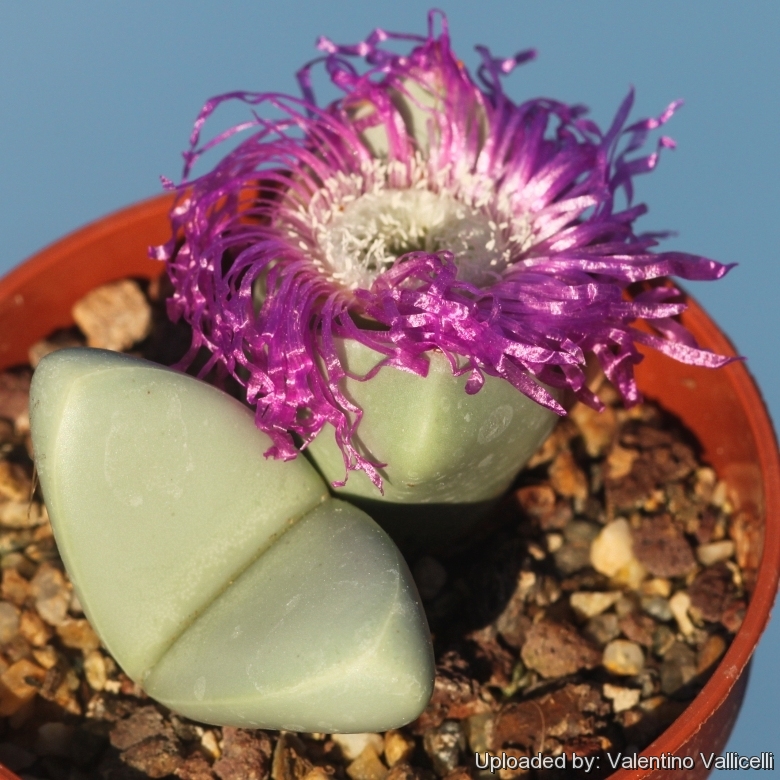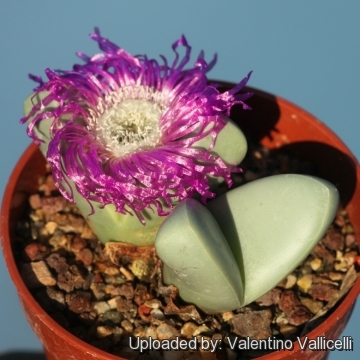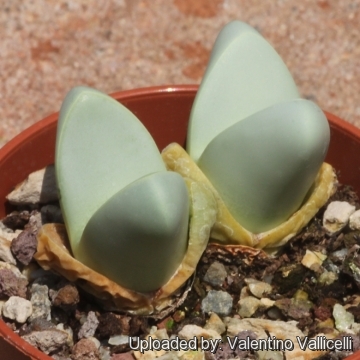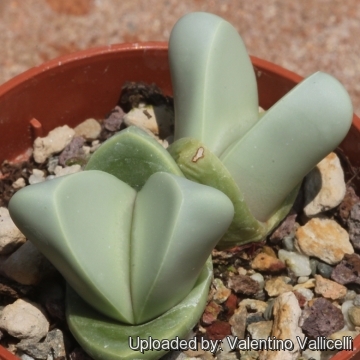
Argyroderma patens Photo by: Valentino Vallicelli
Origin and Habitat: South Africa. It is endemic from the quartz fields in the Knersvlakte north of the South River, and is locally abundant. It is often foun in association with Argyroderma fissumSN|842]]SN|825]], Argyroderma crateriformis and Argyroderma framesiiSN|825]]SN|842]].
Synonyms:
Common Names include:
ENGLISH: Blue Pebbles, Living Rock, Ice Plant, Blue Stone Plants
Description: This plant is a nano-chamaephyte that consist of a pair of fleshy leaves, either in clusters or singly. It may form in time small clusters of less than 10 heads of up to 80 mm in diameter. It is immediately distinguished from other species by its very widely spreading leaves. It is delightful when staged with the smooth stones it resembles.
Body (Paired leaves): Leaves 2-4 cm hight x 1,5-2 cm wide, half-ovoid, rounded slightly compressed and keeled below, silvery-blue to greyish-silver older leaves rusty-brown, cut almost in two along their width, with a v-shaped fissure extending along the cut, connate for at least one-third with widely spread apexes ( free apex 1-2 cm long, gap between the leaves 2-45 mm wide). Each half of the cut open egg is actually a greatly thickened leaf, and each year a new set of leaves appears in the fissure, arranged perpendicularly to the preceding pair of leaves.
Stems: Very reduced vertically compressed (internodes not visible)
Flowers: Sessile, about 3 cm in diameter, daisy like from the junction, bright yellow, bronze, purple, magenta-pink or white, the petals open and close daily and are anticlockwise even when spent. Calyx-tube convex, narrowed at the top
Blooming season: Flowers appear late in autumn or winter.
Capsules: Globose, mostly 10-12 locular, bracts entirely chestnut or spotted, not touching the base of the capsules.
Remarks: These succulent plants are popular among cacti and succulent plant growers, although rather rare in collections in spite of being very interesting plant for their unique shapes and colourful flowers. What appeals to most people is the fact that the plants will often resembles chubby, quartz egg-shaped pebbles with a silvery sheen of the land they are native too. The plants evolved to look like stones in order to evade detection and consumption by animals.
 Argyroderma patens Photo by: Valentino Vallicelli
Argyroderma patens Photo by: Valentino Vallicelli Argyroderma patens Photo by: Valentino Vallicelli
Argyroderma patens Photo by: Valentino Vallicelli Argyroderma patens Photo by: Valentino Vallicelli
Argyroderma patens Photo by: Valentino VallicelliSend a photo of this plant.The gallery now contains thousands of pictures, however it is possible to do even more. We are, of course, seeking photos of species not yet shown in the gallery but not only that, we are also looking for better pictures than those already present.
Read More... Cultivation and Propagation: Argyroderma is easy to grow. Argyroderma are more forgiving than Lithops of excess water (though it should be rarely given in summer) and thrive in light winter rains in temperate climates and were heading for summer dormancy.
Soil requirements: It needs a very draining mineral, rather acidic, substrate. A mixture comprising 20 % pumice grit, 20% lava grit, 20% quartz grit, 20% coarse river sand and 20 % garden soil seems well suited.
Water needs: Requires little water otherwise its epidermis breaks (resulting in unsightly scars). Water minimally in summer, only when the plant starts shrivelling. But be careful with watering (rot sensitive).
Fertilization: Fertilize moderately during the growing season with diluted high potassium fertilizer.
Hardiness: It is fairly cold resistant and hardy to -5°C (or less if dry) depending on the clone.
Exposure: Need full sun, (with insufficient illumination bodies get thinner as a result of the lack of sun) but keep cool and shaded in summer,
Propagation: Seeds or division of larger clumps. Argyroderma is very easy to start from seed. Seeds germinate in 7-14 days at 21°C. Although they will start from cuttings, it is quite difficult to get them to root. If they start to rot there is usually part of the plant that can be removed and possibly rooted.













